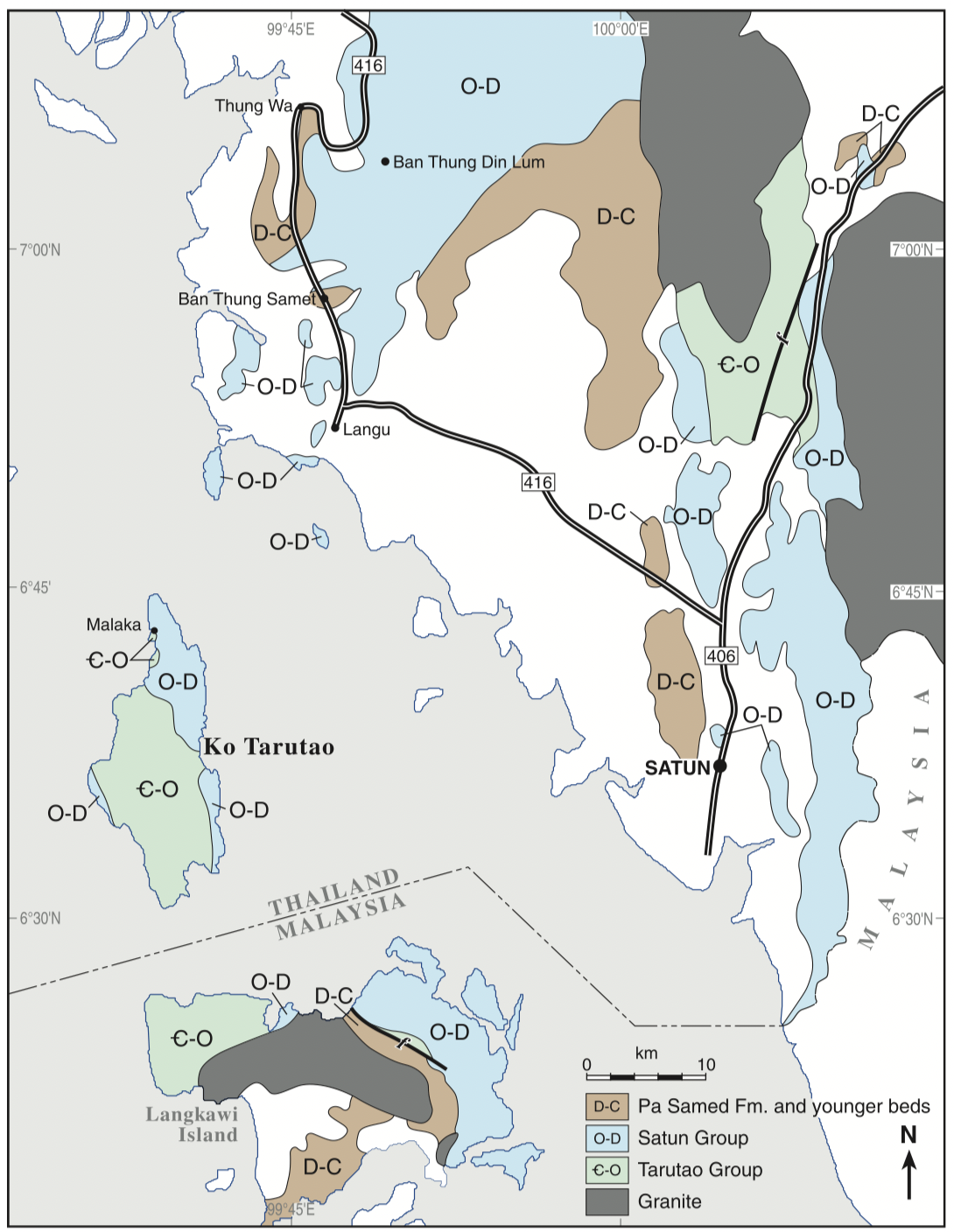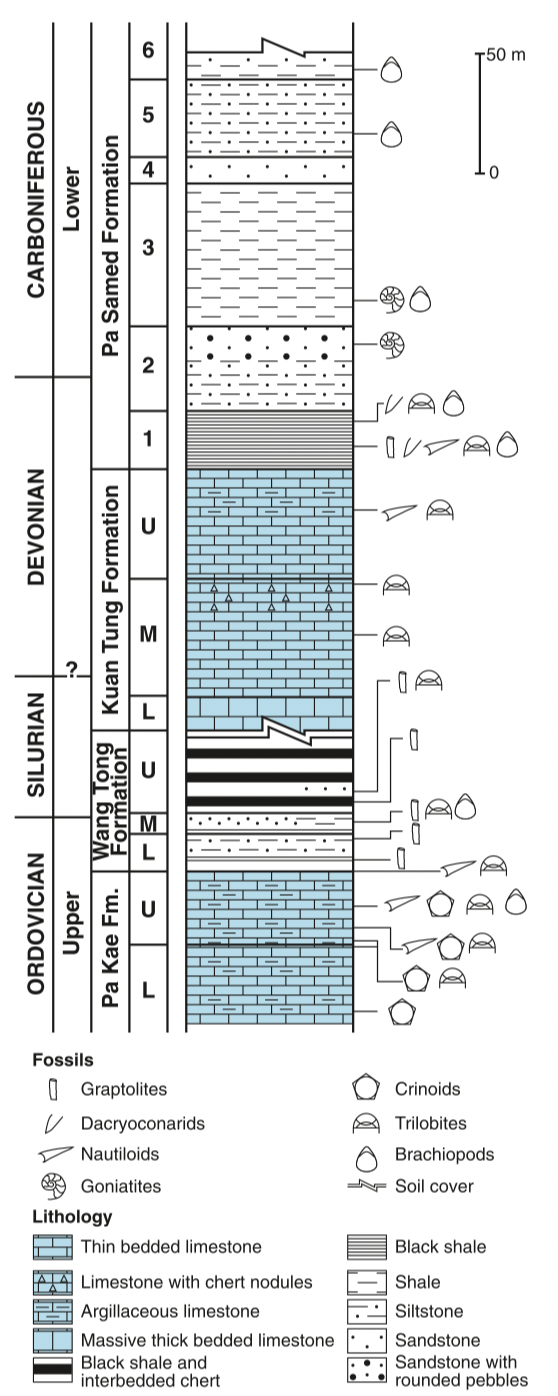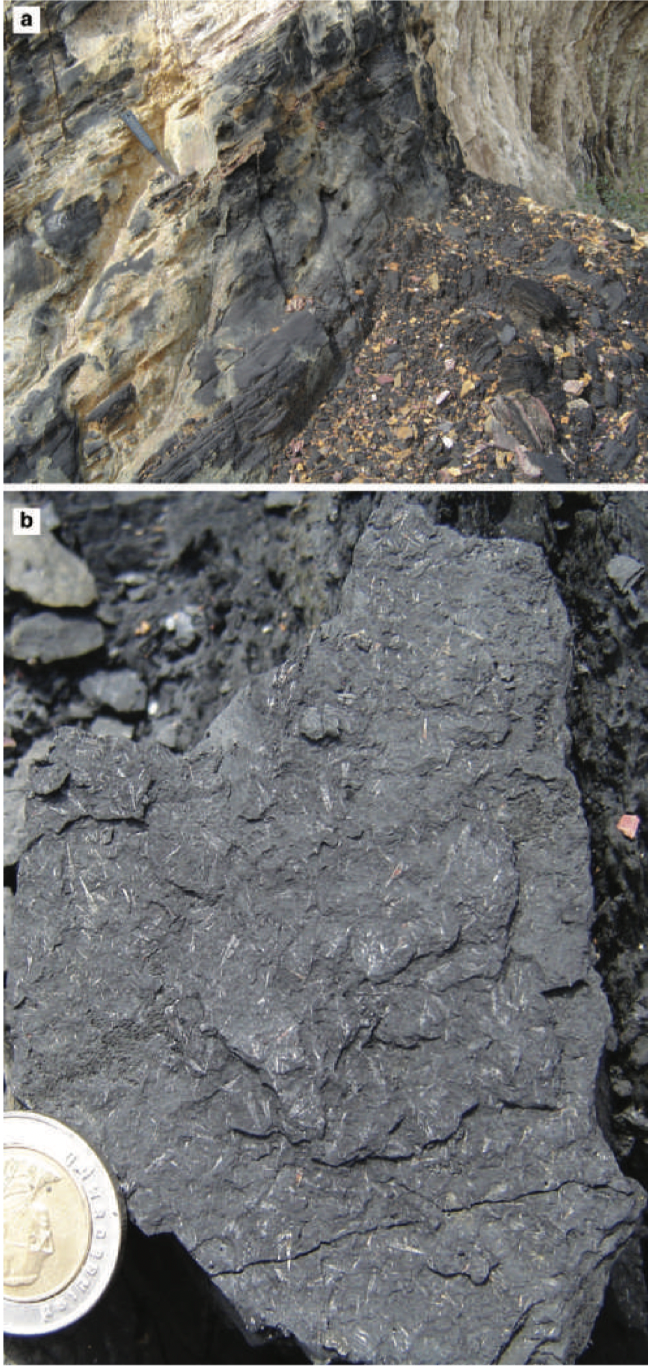Pa Samed Fm
Type Locality and Naming
Remarks: The formation was originally written the Pa Sa Med Fm (Tansuwan and others, 1982), named after Pa Samed village, about 9 km north of Langu district, Satun province. Parent unit: As part of Thong Pha Phum Gr (Wongwanich and others, 1990), but Ridd (2011) assigned it as part of the Devonian-Carboniferous Nga Chang Supergroup Gr.
[Figure: Sketch geological map (from various sources) of the southern part of Peninsular Thailand and Langkawi Island of Malaysia. Note that Thai stratigraphic nomenclature has been extended to Langkawi Island (Ridd. 2011)]
Synonym: หมวดหินป่าเสม็ด , Originally written as Pa Sa Med Fm (Tansuwan and others, 1982).
Lithology and Thickness
Member One consists of 25 m of brown-weathering, black, tentaculitic shale with trilobites, brachiopods, graptolites, small nautiloids and abundant dacryoconarid tentaculitids. The fossils were identified by DMR palaeontologists as Early Devonian Nowakia, Metastyliolina, Styliolina, Echinocoeliopsis, Plagiolaria, Echinocoelia and Monograptus. Agematsu et al. (2006a) confirmed only Nowakia acuaria in the lowermost part of this unit.
Member Two consists of 35 m of fine- to medium-grained sandstone interbedded with minor shale. The lower unit is thick-bedded to massive, brownish grey to dark red sandstone, with graded bedding and wavy bases interbedded with very thin-bedded red shale. The upper unit consists of thick to thin-bedded, brown to grey sandstone with pebbles, graded bedding, lamination, cross-lamination and two Carboniferous goniatite beds intercalated with brown shale (see discussion below). The upper part of this unit consists of massive, grey, pebbly sandstone interbedded with thinly laminated shale.
Member Three consists of 55 m of grey argillaceous limestone or brown decalcified shale in 2–5 cm thick beds, which is laminated and sphaeroidally weathered. It changes to very dark grey laminated shale with an abundant fauna including small Namurian brachiopods and goniatites in the west.
Member Four is 8–10 m of grey to light brown, massively bedded fine-grained sandstone. Sorting is poor and pebbles rare.
Member Five consists of 30 m of brown, reddish brown, fine-grained sandstone interbedded with laminated red shale.
Member Six consists of 12 m of brownish grey, fine-grained sandstone with grey shale lenses.
Thickness: The total thickness of the Pa Samed Formation is 167 m.. New excavations on the south side of the section have revealed more than 400 m of greenish to dark grey laminated shale, mudstone, siltstone and some sandstone with trace fossils, more abundant in some beds than others, lying conformably above Member Six (Wongwanich et al. 2004). The total thickness of the Pa Samed Formation is therefore over 567 m, but the Devonian part at the bottom of the formation is probably only 25 m thick (Wongwanich & Boucot, 2011).
[Figure 1: Composite stratigraphic column of the Upper Ordovician-Carboniferous between Km 9.5 and Km 11 kilometer posts beside the La Ngu to Tung Wa road, Satun Province. A possible disconformity is inferred between the Carboniferous and Lower Devonian at about the level of unit 2 of the Pa Samed Formation (modified from Wongwanich et al. 1990, 2001, 2002). (Wongwanich & Boucot, 2011).]
[Figure 2: (a) and (b) Black pyritic shale with abundant tentaculites of the Devonian Pa Samed Formation. Quarry at Ban Khuan Khan, SW of Satun town, Satun Province. The coin measures 2.6 cm diameter (photographs courtesy of M. F. Ridd) (Wongwanich & Boucot, 2011).]
Relationships and Distribution
Lower contact
Upper contact
Regional extent
GeoJSON
Fossils
Age
Depositional setting
The sequence is interpreted as deposited in a deep-water euxinic marine basin (Member One) to slope channels (Member Two) and deeper water (Members Three–Six). The red sandstone and shale within Members Two and Five may be the result of the deep-water deposition of weathering products
Additional Information


